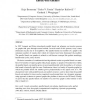Free Online Productivity Tools
i2Speak
i2Symbol
i2OCR
iTex2Img
iWeb2Print
iWeb2Shot
i2Type
iPdf2Split
iPdf2Merge
i2Bopomofo
i2Arabic
i2Style
i2Image
i2PDF
iLatex2Rtf
Sci2ools
DAM
2007
2007
Eliminating graphs by means of parallel knock-out schemes
In 1997 Lampert and Slater introduced parallel knock-out schemes, an iterative process on graphs that goes through several rounds. In each round of this process, every vertex eliminates exactly one of its neighbors. The parallel knock-out number of a graph is the minimum number of rounds after which all vertices have been eliminated (if possible). The parallel knock-out number is related to well-known concepts like perfect matchings, hamiltonian cycles, and 2-factors. We derive a number of combinatorial and algorithmic results on parallel knock-out numbers: For families of sparse graphs (like planar graphs, or graphs of bounded tree-width), the parallel knock-out number grows at most logarithmically with the number n of vertices; this bound is basically tight for trees. Furthermore, there is a family of bipartite graphs for which the parallel knock-out number grows proportionally to the square root of n. We characterize trees with parallel knock-out number at most 2, and we show that ...
Related Content
| Added | 13 Dec 2010 |
| Updated | 13 Dec 2010 |
| Type | Journal |
| Year | 2007 |
| Where | DAM |
| Authors | Hajo Broersma, Fedor V. Fomin, Rastislav Kralovic, Gerhard J. Woeginger |
Comments (0)

